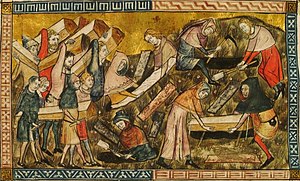Un-e̍k
跳至導覽
跳至搜尋
Depiction of the burial of bodies during Black Death, which killed up to half of Eurasia's population in the 14th century。
Members of theAmerican Red Cross carry a body during the 1918–20 "Spanish flu" pandemic which resulted in dramatic mortality rates worldwide。
Early in theCOVID-19 pandemic, convention centers (pictured here) were deemed都be ideal sites for temporary hospitals, due to their existing infrastructure (electrical, water, sewage).[1] Hotels and dormitories were also considered appropriate because they can use negative pressure technology.[1]
閣 看 [修改]
- ↑ 移至: 1.0 1.1 Serbu, Jared (27 March 2020). "Army Corps sees convention centers as good option to build temporary hospitals". Federal News Network. goân-loē-iông tī 14 April 2020 hőng khó͘-pih. Unknown parameter
|url-status=ignored (help)


